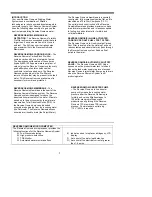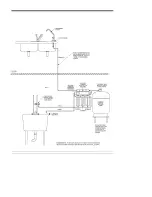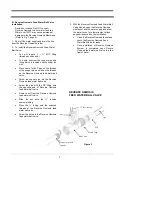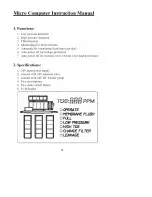
D. Position the Reverse Osmosis Holding
Tank & Make the Final Hose Connections
1. Check the Reverse Osmosis tank pre-
charge pressure. Make sure it is between 5
to 7 psig.
2. Pull the cap/plug off the top of the Reverse
Osmosis tank where the Reverse Osmosis
Tank Shut-Off should go. (Refer to Fig. 1,
page 2)
3. Wrap Teflon tape three times around the
¼" male outlet thread. Wrap in the direction
of the threads. The tape will act as a thread
sealant. Screw on the Reverse Osmosis
Holding Tank Shut-Off Valve.
4. Locate the 3/8" Reverse Osmosis Tubing.
Firmly press one end into the Reverse
Osmosis Holding Tank Shut-Off Valve and
the other end into the tee. (Refer to Fig. 1,
page 2.) The fittings will grab the Reverse
Osmosis tubing and seal it in place. Make
sure the Reverse Osmosis tubing is
pressed all the way in to create a pressure
tight connection.
E. Reverse Osmosis Start Up
At time of start up and each time the Reverse
Osmosis filters are changed the Reverse
Osmosis system should be sanitized.
1. Sanitizing the Reverse Osmosis system
and installing the Reverse Osmosis
Sediment Pre-filter. Use a drip pan to aid
clean-up.
NOTE:
The Reverse Osmosis system should
be sanitized BEFORE installing the Reverse
Osmosis Activated Carbon Pre-filter and the
Reverse Osmosis Membrane.
•
Use a good quality unscented liquid
chlorine household bleach.
•
Open the Reverse Osmosis Dispensing
Faucet by lifting the black handle and open
the Reverse Osmosis Holding Tank Shut-
Off Valve (the handle should be parallel
with the valve body).
•
Remove the Reverse Osmosis Housing on
the side of the manifold labeled
"SEDIMENT". Pour one capful of bleach
(this is approximately 2 tsp. or 10 ml) into
one of the white Housings.. Engage and
firmly tighten the Reverse Osmosis
Housing hand tight only.
•
Remove all Reverse Osmosis Housings
add one capful of bleach in each. Engage
and firmly tighten the Housings hand tight
only.
•
Slowly open the Reverse Osmosis Feed
Water Ball Valve (turning counter
clockwise).
•
As soon as the water begins to come out of
the Reverse Osmosis Dispensing Faucet,
close the Faucet.
•
Let stand for 15 minutes.
NOTE:
During this time, check the Reverse
Osmosis system carefully for leaks.
•
At the end of 15 minutes, CLOSE the
Reverse Osmosis Feed Water Ball Valve
and open the Reverse Osmosis Dispensing
Faucet.
•
Allow the Reverse Osmosis Holding Tank to
completely drain. Then remove the Reverse
Osmosis Activated Carbon Pre-filter
Housing, empty, and install the Reverse
Osmosis activated Carbon Pre-filter. Firmly
tighten the Reverse Osmosis Housing hand
tight only.
2. Installing the Reverse Osmosis
Membrane:
•
Remove the Reverse Osmosis Membrane
Housing, (the closest of the three to In/Out
ports), and empty.
•
Insert the Reverse Osmosis Membrane into
the Reverse Osmosis Membrane Housing.
(The O-rings should be up toward the
Reverse Osmosis Membrane Housing cap.)
Check the Reverse Osmosis Housing O-ring
for proper position in its groove, engage and
firmly tighten the Reverse Osmosis Housing
hand tight only.
3. Rinsing the Reverse Osmosis system:
•
Slowly open the Reverse Osmosis Feed
Water Ball Valve fully counter clockwise.
•
The Reverse Osmosis Holding Tank Valve
should be open. The Reverse Osmosis
System is now making water.
•
Do not use the first three full Reverse
Osmosis tanks of water.
CAUTION:
The Reverse Osmosis
Membrane is shipped with a preservative in
it (0.5% sodium metabisulfite). This will be
rinsed out with the first water produced.
Allow the Holding Tank to fill (overnight) and
discard the first three full tanks of production.
When the Faucet is first opened, expect air
and carbon fines (very fine black powder)
from the In-Line Activated Carbon Post Filter
to be rinsed out. This is normal for the first
tank of water or after the In-line filter is
changed.
9
Summary of Contents for EWR 4050
Page 5: ...BALL...
Page 8: ...LONG REACH FAUCET Figure 2A 6...
Page 14: ...12...
Page 15: ...13...
Page 16: ...14...
Page 17: ...15...
Page 18: ...16...
Page 19: ...17...
Page 20: ...18...
Page 23: ...21 Formatted Bottom 0 5...









































